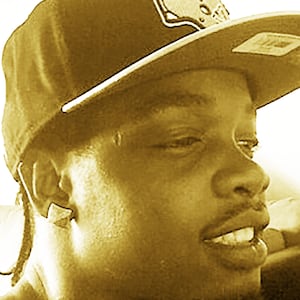On June 10, two weeks into sustained national protest against police brutality, an Ohio cop named Anthony Johnson uploaded a TikTok with the caption, “The time I found out Scotland doesn’t have any good cereal! 🤣🤷🏽♂️.” The video shows him in a backwards cap and a navy shirt that reads “HUMANIZE,” with a ThinBlueLine badge where the “A” should be. He’s on an Instagram Live chat with a Scottish teenager, talking about the U.K.’s breakfast cereal options. “We don’t even have Fruit Loops here,” the teen tells him. Johnson is gobsmacked. He cannot believe it: “I love Fruit Loops,” he says. The video got 51,600 views.
Johnson, who posts under the handle @OhNoItsDaPoPo, gained a following on social media in 2015 after a video of him dancing with local kids to iLoveMemphis’ “Hit the Quan” went viral. At that point, the so-called “Dancing Cop,” who joined the Columbus force around 2010, had been on Instagram for several years, posting videos, as he put it, “to combat the negativity” of news involving law enforcement. He maintained a substantial fan base of about 182,000 followers by sharing clips of himself playing with kids, checking in on neighbors, and rapping about his own upbringing in “Uzi Alley,” a former public housing complex in Columbus. But Johnson didn’t really blow up until last May, when a colleague recommended he move the act to TikTok. “It caught on way faster than any other platform,” Johnson said. He now has 1.2 million followers.
Just three weeks after his first TikTok, Johnson wound up with another viral video: a body camera clip of the Dancing Cop sucker-punching an unarmed 25-year-old Black man named in the jaw. The clip came from an incident on June 7, 2019, when a “ShotSpotter” gunfire detection device recorded gunshots in a local alleyway, dispatching 10 police officers to a local man’s home. According to a federal lawsuit filed against the City of Columbus that names Johnson as a defendant, the officers searched the house without a warrant, questioned the owner’s young children, and found nothing on the premises except a toy BB gun.
The body camera footage shows a man named Jonathan Robinson and his wife arguing with a police officer over whether they can retrieve children from the house. In the clip, Johnson walks up to Robinson from behind, pushes him in the chest, and then punches him in the face. “I can’t comment on that right now,” Johnson said, due to the pending litigation. It did not make it onto his TikTok feed.
In the past three weeks of protests since George Floyd’s killing at the hands of the Minneapolis police, TikTok has become an outlet for organizers to share footage from gatherings, protest resources, legal advice, and general support from those who can’t leave their lockdowns. In some ways, it was an unlikely activist platform—critics have slammed the video-sharing app for censoring users they found to be “ugly” or “poor”; for an app error that temporarily blocked the “#blacklivesmatter hashtag, among others; and for the uneven application of community guidelines that Black creators said removed videos discussing racism. (TikTok has yet to provide comment for this story.)
The past month of activism has overwhelmed those factors. On May 19th, Black users changed their profile pictures en masse to a Power Fist in protest of the app’s community rules. On Blackout Tuesday, the app published an apology, announcing a $3 million donation to nonprofits “that help the Black Community,” and an additional $1 million toward “fighting racial injustice and inequality.” Around the same time, the app fixed its hashtag error: on Sunday, #blacklivesmatter had been viewed over 10 billion times.
But the protesters have not been the only ones harnessing TikTok to talk about police. For years, the app has been home to a swath of police officers and BlueLivesMatter activists using the platform much like Johnson does, for image management. Collected around hashtags like #CopsofTikTok, #ThinBlueLine, #BackTheBlue, #HumanizetheBadge, #Police, #Cops, #Coplife, #K9, or #BlueLivesMatter, TikTok cops share videos naming their weapons, dosing themselves with pepper spray, or running obstacle courses. They also mimicked many of the app’s trends—dancing to popular audio tracks, lip-syncing to clips of baby voices, jumping into another officer’s arms, or walking into a bathroom to reveal, in the mirror, that they’re holding a giant dog.
In the past few weeks, patterns that emerged across Black Lives Matter TikTok wound up refracted in Blue Lives Matter TikTok. As feeds began to fill with videos from protests, police hashtags appeared on similar footage, but shot from the opposing view—tape of so-called “rioters,” incidents of police officers kneeling with protesters, or footage from counter-protests, as attendees chanted “Back The Blue” or “We Got Your Six.” After the Power Fist picture began to dominate profiles in May, for example, pro-police users began adopting altered versions—most frequently, a fist overlaid with the Thin Blue Line stripes. Others used the GOP elephant, a fist flicking the bird, or more graphic material.
The motivations behind cop TikTok have always been clear. “I was just tired of everything being so negative involving law enforcement,” Johnson said. “Because anytime I would turn on the radio, anytime I would pop on social media, it was always something negative. You never heard anything positive.” It’s always been overt copaganda, a way to distract from the systemic problems in policing with anecdotes of isolated incidents. The problems with it are even clearer in Johnson’s case: it’s selective, cherry-picking moments of solidarity, without addressing questions of budgeting, militarization, or repercussions for brutality.


